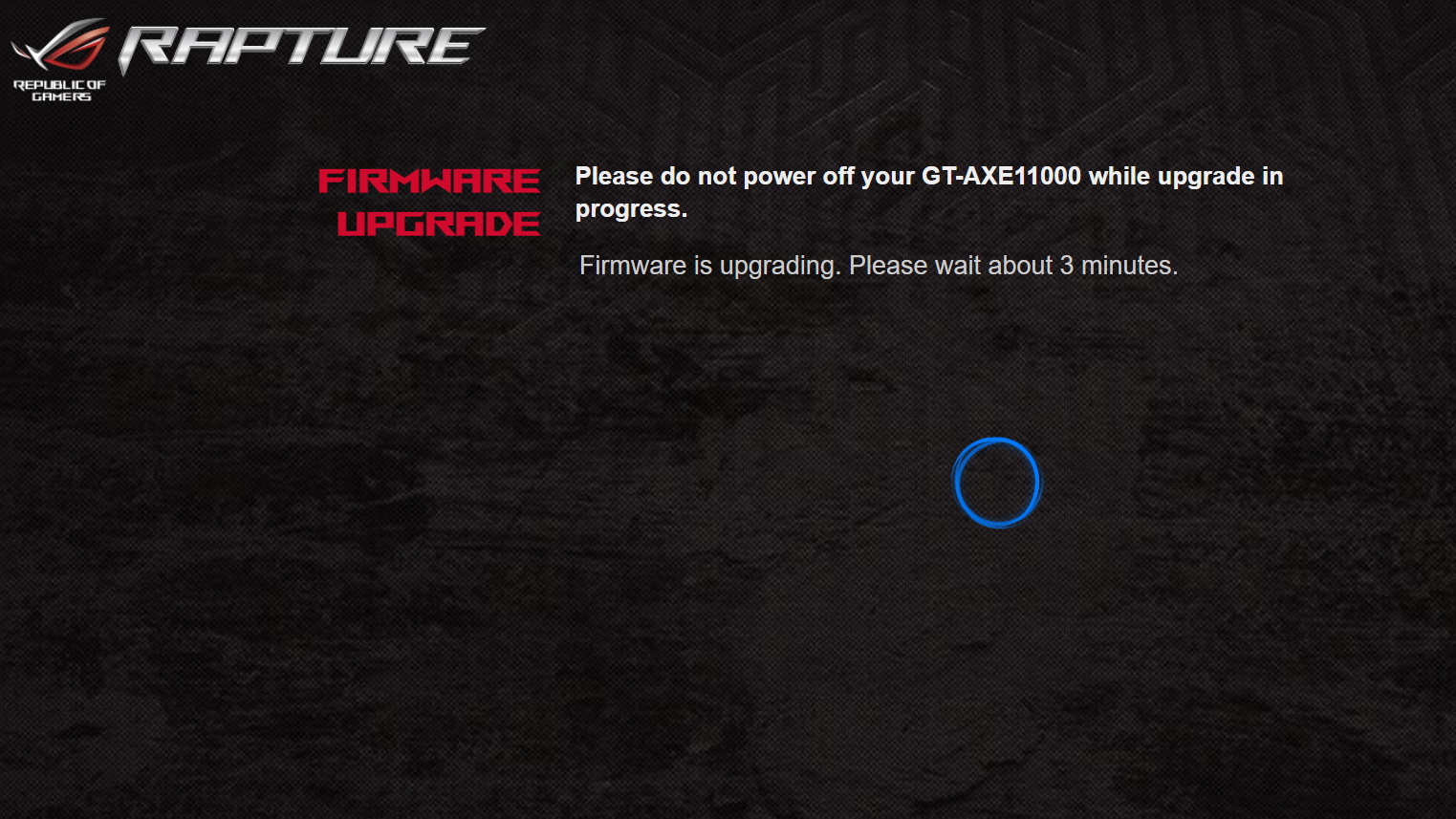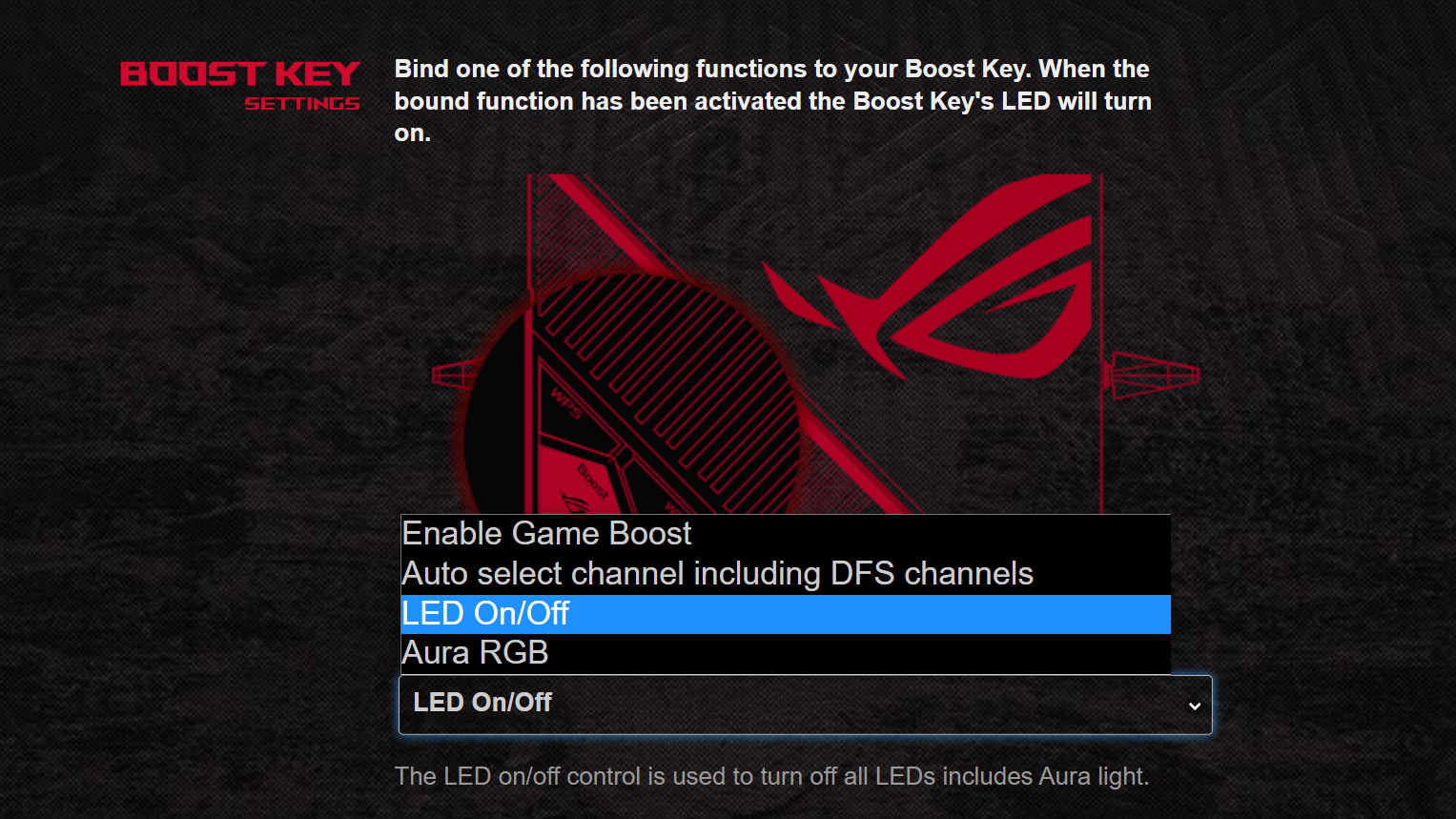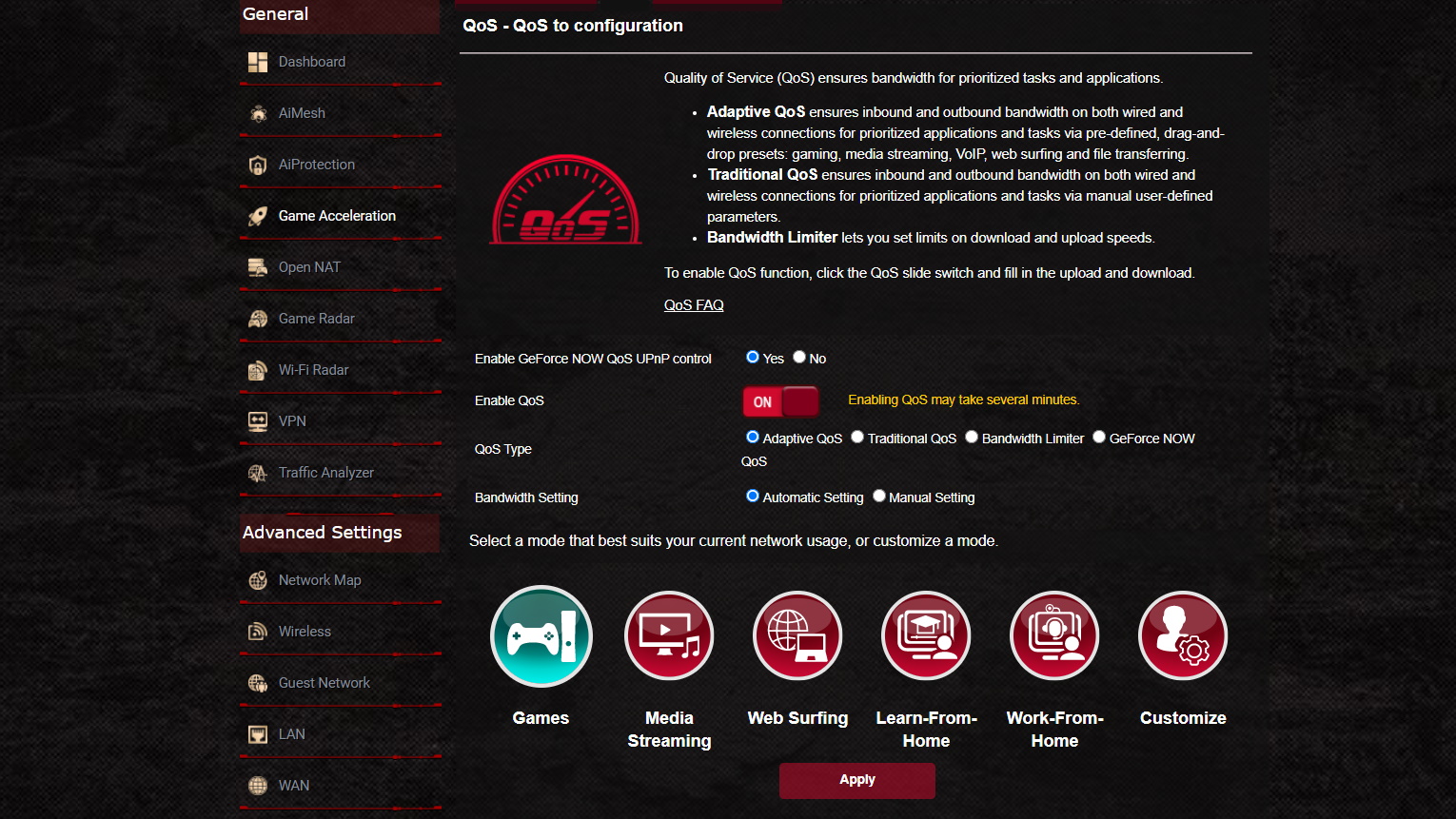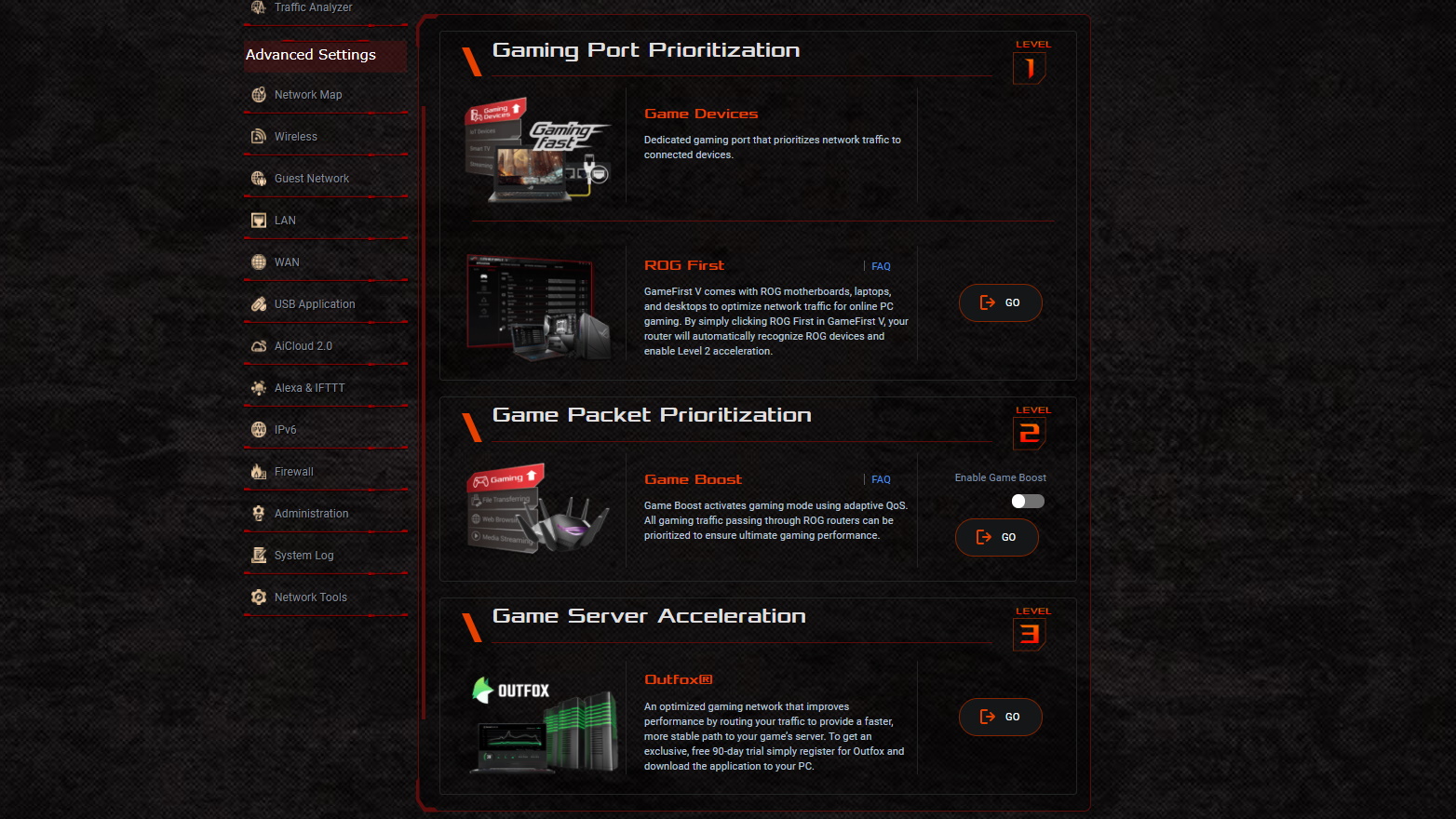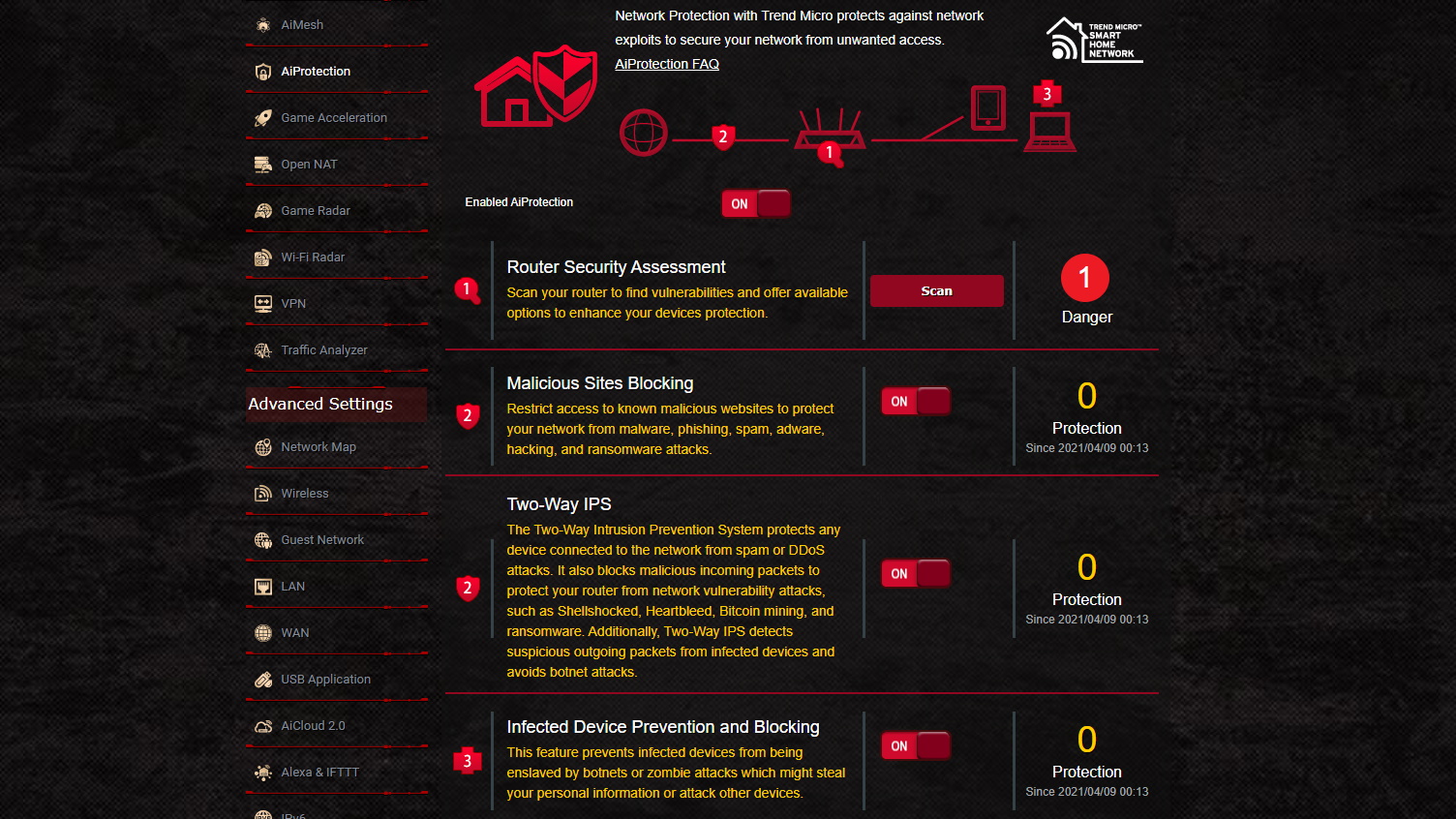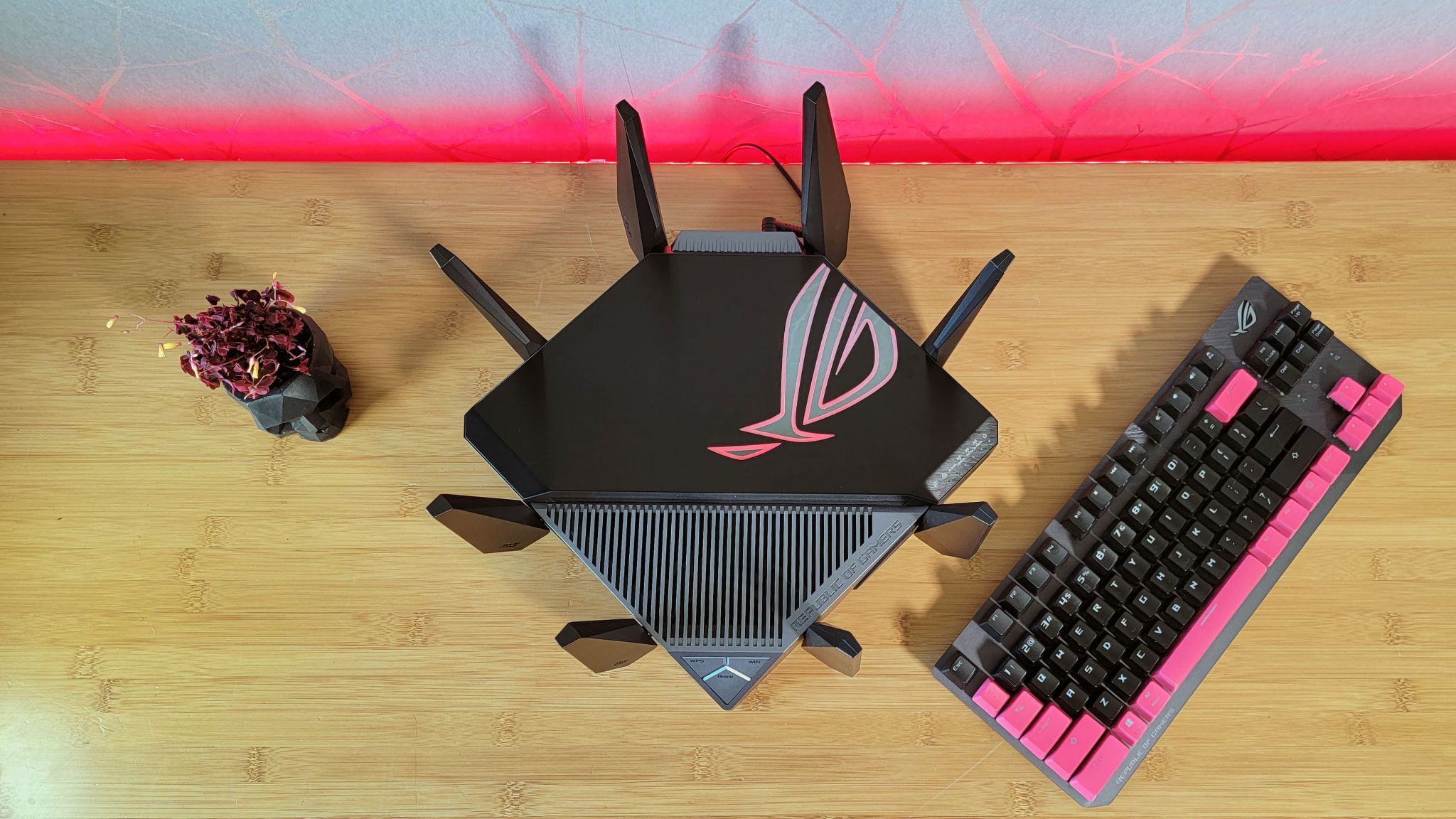Tom's Hardware Verdict
The Asus ROG Rapture GT-AXE11000 gaming router is versatile and supports the latest Wi-Fi 6E wireless standard. But its high price, plus disappointing tested performance with network congestion hold it back.
Pros
- +
+ Latest Wi-Fi 6E wireless standard
- +
+ Included security subscription
- +
+ Very fast throughput
- +
+ Flexible Ethernet ports
- +
+ Supports OutFox
- +
+ Ease of setup
Cons
- -
- Big and expensive
- -
- Latest firmware has QoS issues
- -
- Wi-Fi 6E devices still nascent
Why you can trust Tom's Hardware
For those that want their network to be on the cutting edge of wireless standards, the Asus Wi-Fi 6E Gaming Router, also known as the ROG Rapture GT-AXE11000, is certainly worth a close look. As part of the Republic of Gamers line, it looks the part of a high-end gaming device, with lots of antennas, stylized angles, and lights.
Wi-Fi 6E is a recent development in wireless standards, following on not soon after Wi-Fi 6. You can check out all the upgrades over Wi-Fi 6 here. But for those who want the CliffsNotes version, this latest wireless standard adds an additional frequency of 6 GHz with less interference, offers lower latency, and provides a total of seven 160 MHz ultra-wide channels to enhance data transfer.
However, realize for now that Wi-Fi 6E-capable clients are quite limited, and we had to perform our testing with a Wi-Fi 6 card. So it may take some time to realize the full benefit of this router's cutting-edge capabilities. Then again, future-proofing a purchase can often be a good strategy, especially in high-end hardware. If you're dropping $549 on a router like the GT-AXE11000, you don't want it to be out of date in a month--or a year.
Design
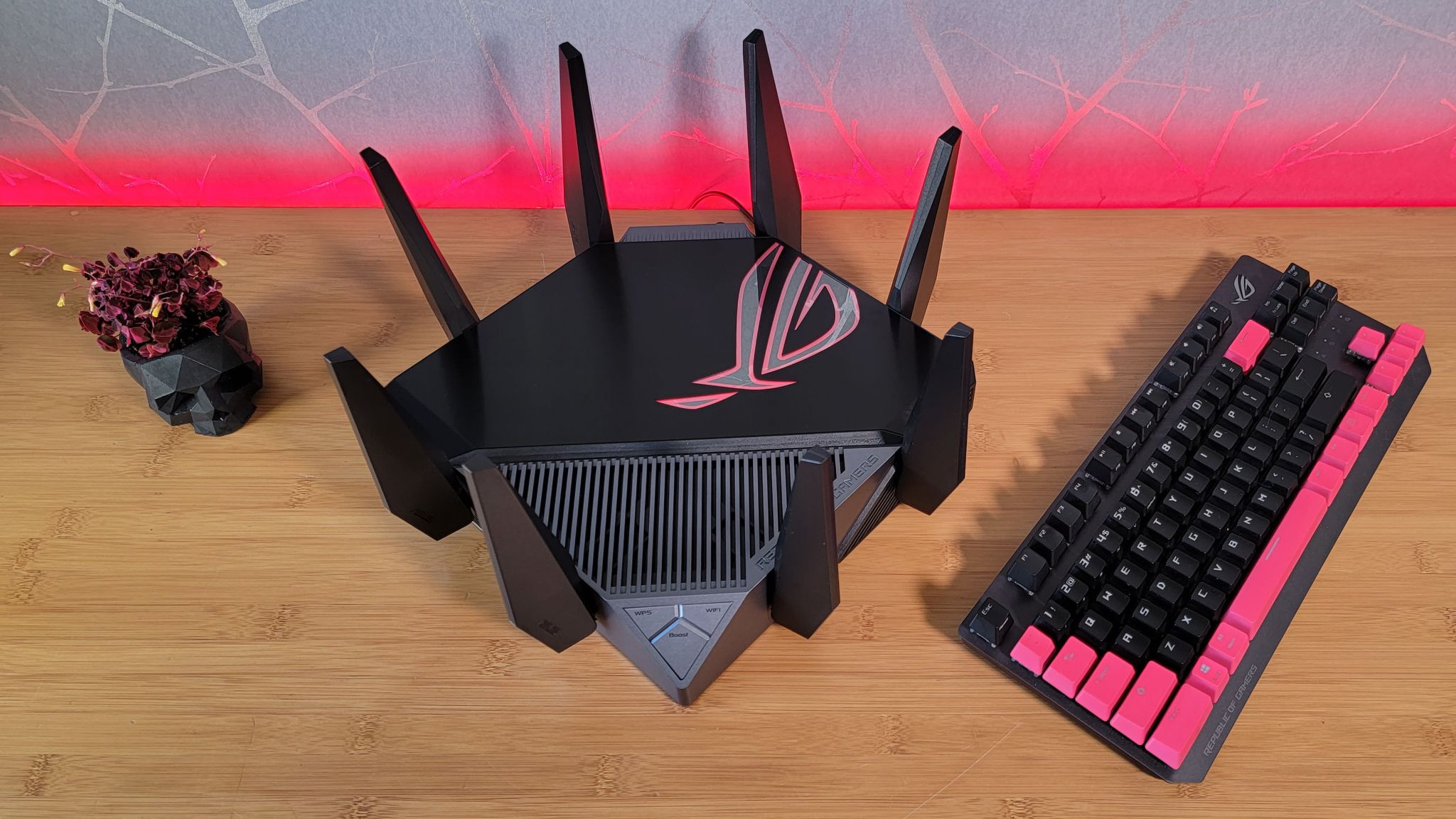

As is fairly typical for a high-end router, the ROG Rapture GT-AXE11000 goes with a horizontal design, with eight large and positionable antennas. This router does have some visually interesting angles at the corners, which give it a modern appearance without looking overdone. We also appreciate that it has a physical power switch for easy resets. At 10.4 x 10.4 x 2.9 inches (26.4 x 26.4x 7.4 cm) and weighing 3.94 lbs (1.79 kg), it's certainly a large router. And it's emblazoned with the ROG logo across the top that has RGB LED’s for illumination.
We also appreciate that the lit logo can be turned off to accommodate bedroom or TV room deployment. A dedicated power switch, recessed reset button, and a pair of USB 3.2 ports round out the package.
Specifications of the Asus ROG Rapture GT-AXE11000 WiFi 6E
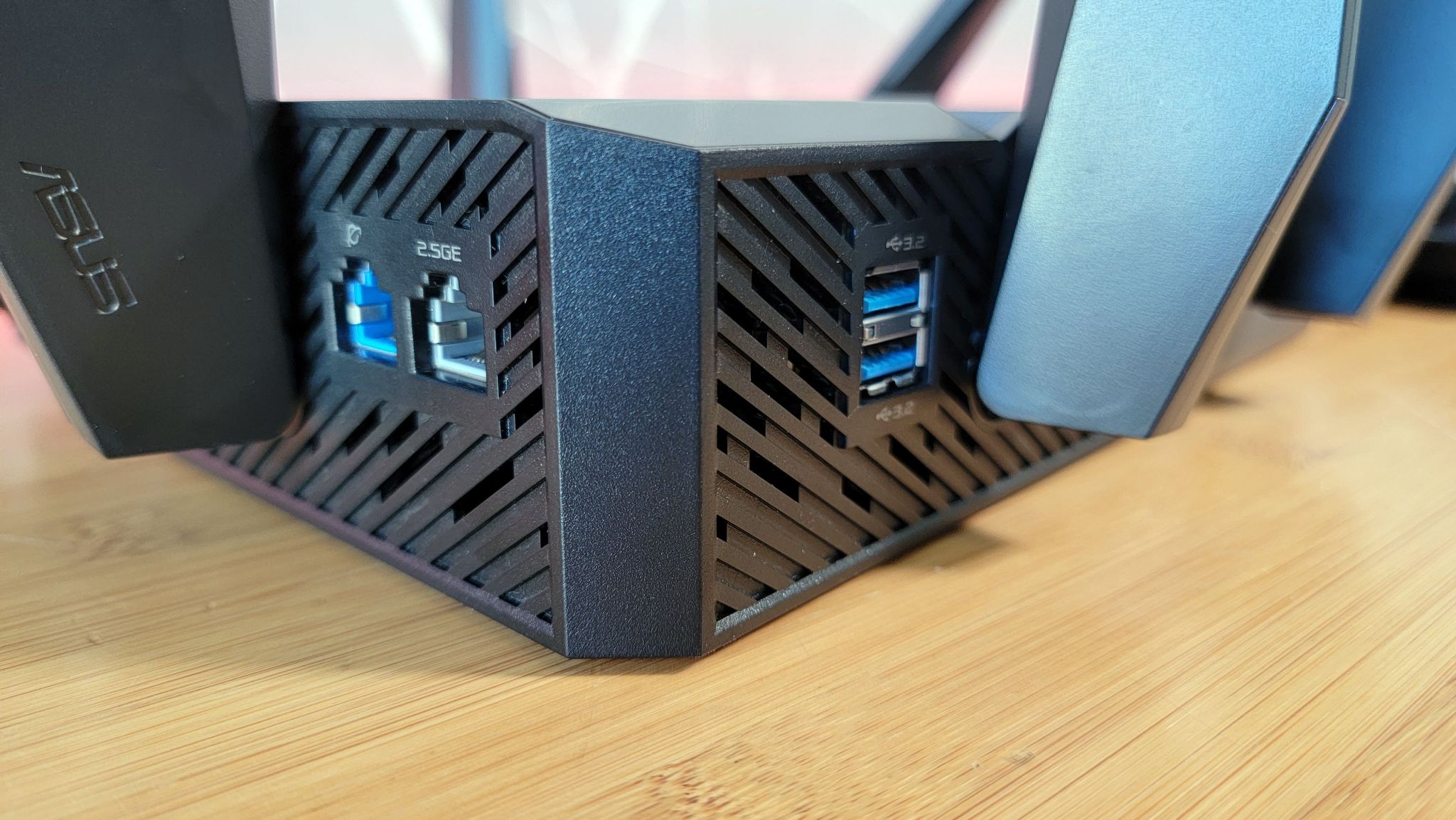
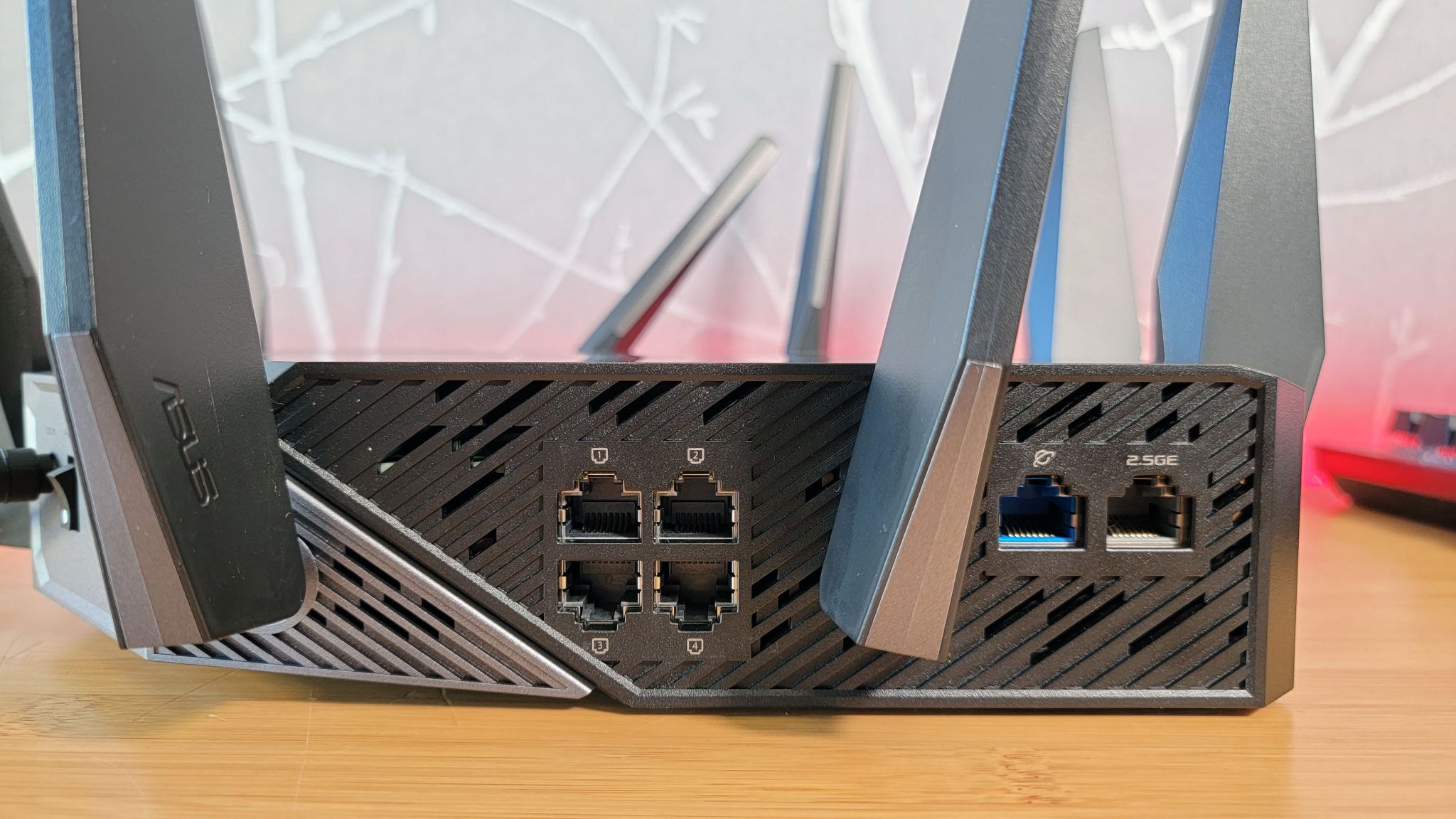
Aside from USB, the GT-AXE11000 has an assortment of ports that offers some options not found in lesser routers. To start, there are four Gigabit LAN ports and a Gigabit WAN port. Then this router takes it a step further with a 2.5G WAN/LAN port, which adds some flexibility and is designed to offer ‘top priority’ to data sent through this port. There is also an option to do Link Aggregation to use both the Gigabit WAN port and the flexible LAN/WAN port as an additional Gigabit port for higher-bandwidth WAN. The hardware specs for this router include a 64-bit, 1.8 GHz quad-core CPU, 256 MB of flash storage and 1 GB of RAM.
The GT-AXE11000 is a tri-band router, although with Wi-Fi 6E things are somewhat different than previous tri-band routers, which typically have a single 2.4 GHz frequency and dual 5 GHz frequencies. The GT-AXE11000 has a 2.4 GHz frequency for up to 1148 Mbps of throughput, a 5 GHz frequency for 4804 Mbps, and a 6 GHz frequency for another 4804 Mbps. Add those all together and, with the usual rounding that happens in networking total throughput, we come to the nice round number of 11,000 Mbps of total throughput.
Get Tom's Hardware's best news and in-depth reviews, straight to your inbox.
Setup of the Asus ROG Rapture GT-AXE11000 WiFi 6E
Setup of the GT-AXE11000 was typical, and we applaud that Asus does let you use a browser (which we prefer) if you don't want to use a smartphone app. As setup proceeds, there is an opportunity to choose a Wi-Fi password and a router password. Along the way, the firmware is upgraded to the latest as well--an important step to get all the recent bug fixes and security patches. Although as we experienced later in testing, the latest firmware isn't always the route to the best performance. More on that later.
Features
A nice feature for this router is the dedicated Hardware Boost key, which can actually be set in the software to one of four functions: turning the LEDs on and off, activating Game Boost, controlling the RGB lighting, or auto-selecting the router channels.
The GT-AXE11000 includes the excellent Asus QoS, which we have encountered in their other routers as well. There is a choice of settings, including a custom one for full control. This lets you prioritize gaming traffic for the best experience.
In addition, the GT-AXE11000 has three extra levels of prioritization for gaming traffic. The first is a dedicated gaming port to connect the gaming PC to, and acceleration that recognizes ROG devices. The second is Game Packet Prioritization via Game Boost. The third level is OutFox, the gamer’s private network (GPN), which only comes with a 90-day subscription, and appears to be a replacement for WTFast that was included on prior Asus gaming routers.
Security of the Asus ROG Rapture GT-AXE11000 WiFi 6E
The GT-AXE11000 includes network-level security, powered by Trend Micro, and a subscription is included. It has several features: There's Router Security Assessment, Malicious Site Blocking, Two-Way Intrusion Prevention System, and blocking of infected devices. This is useful to keep the entire network clear of malicious software, rather than relying solely on anti-malware software on your computer.
Performance of the Asus ROG Rapture GT-AXE11000 WiFi 6E
| 2.4 GHz near | 2.4 GHz far | 5 GHz near | 5 GHz far |
|---|---|---|---|
| 386.3 Mbps | 212.9 Mbps | 1401.2 Mbps | 1142.5 Mbps |
Testing a Wi-Fi 6E router is a challenge when there are such limited Wi-Fi 6E clients. Our testing was done using an Intel AX201 wireless card with the 22.40.0.7 driver. While it supports Wi-Fi 6, it does not support Wi-Fi 6E, although there is an updated chip, the AX210, that does offer support for this latest standard.
On our testing, even limited with only the Wi-Fi 6 part, this router still mostly impressed us; we got our highest throughput scores to date. The 5 GHz near test was blistering fast at 1401.2 Mbps, and still 1142.5 Mbps when 30 feet away, showing that even without the latest and standard, the router impresses with Wi-Fi 6 devices.
| Testing Configuration | QoS | FRAPS Avg | Max | 8K Dropped Frames | Pingplotter Spikes | Latency |
|---|---|---|---|---|---|---|
| Ethernet | no | 125.5 | 156 | n/a | 0 | 232 |
| Ethernet + 10 8k videos | no | 121.4 | 141 | 58.70% | 1 | 79 |
| Ethernet + 10 8k videos | yes | 117.8 | 131 | 22.60% | 0 | 80 |
| 5 GHz | no | 124 | 152 | n/a | 0 | 58 |
| 5 GHz + 10 8k videos | no | 126.4 | 150 | 32.60% | 0 | 82 |
| 5 GHz + 10 8k videos | yes | 87.4 | 126 | 45.90% | 2 | 142 |
| 2.4 GHz | no | 125.7 | 150 | n/a | 0 | 161 |
| 2.4 GHz + 10 8k videos | no | 102.1 | 136 | 32.40% | 4 | 106 |
| 2.4 GHz + 10 8k videos | yes | 50.7 | 76 | 33.30% | 5 | 130 |
Despite the stupid-fast throughput, the ASUS ROG Rapture GT-AXE11000 WiFi 6E did not deliver a stellar performance in our network congestion testing. Things started off well enough with our laptop connected to the dedicated gaming port, although we cannot explain the higher latency score on our game of Overwatch with no background videos running. Still, the FPS were solid, and with only the game running, we achieved a 125.5 FPS. We also got only a single PingPlotter spike across the three wired tests, and this with the ten 8K background videos streaming and the QoS set to off, so hardly unexpected. The firmware used was the latest, Version 3.0.0.4.386.42489 that debuted last month.
However, the QoS setting was disappointing each time it was turned on and tested. This was curious as we have not encountered this on any other Asus router, which generally deliver excellent performance in network congestion testing. However, the QoS in all three connections tested (wired, 2.4 GHz, 5 GHz), dropped the FPS to the lowest we saw. In other words, the user is better off leaving the QoS off with the latest firmware.
| Testing Configuration | QoS | FRAPS Avg | Max | 8K Dropped Frames | Pingplotter Spikes | Latency |
|---|---|---|---|---|---|---|
| 5 GHz | no | 125.9 | 149 | n/a | 0 | 247 |
| 5 GHz + 10 8k videos | no | 115.4 | 134 | 25.10% | 0 | 316 |
| 5 GHz + 10 8k videos | yes | 125.2 | 144 | 15.90% | 13 | 419 |
| Row 3 - Cell 6 |
Having such poor QoS performance left us surprised, as this brand pretty consistently performs well on our congestion testing. To look into this further, we found the only older version of firmware available for the AXE11000, Version 3.0.0.4.386.42026, and manually flashed the router back to this version. With the older firmware, the latency values all increased, but in the other tests we saw a significant improvement. This included better FPS, as now with the QoS enabled, we saw a nearly identical FPS score with the background videos saturating our network’s bandwidth.
Furthermore, the dropped frame rate was also lower with this firmware both with the QoS on and off. We conclude from our testing that users experiencing an issue with the current firmware at the time of this writing should try their router back with the original firmware, although hopefully Asus will swiftly address the issue in a future update to give both the better latency of the newer firmware, with the better performance on congested networks that we saw when running with the older firmware.
Pricing and Conclusion
All of the bells and whistles from Asus do come at a price. Yes, we now have consumer routers that can compete with a new mainstream laptop in price, as this ROG Rapture GT-AXE11000 has a listed price of $549 on the Asus site. And it's actually priced higher at most other places where we could find it in stock.
The ROG Rapture GT-AXE11000 shows that coming early to a new standard, in this case Wi-Fi 6E, is not without some teething issues. We applaud the really fast Wi-Fi throughput, the ease of setup, the integrated security, the support for OutFox, and the flexibility in the wired ports that offer link aggregation.
However, some serious drawbacks include the high price, the poor QoS performance in our testing with the latest firmware, the large size of the router, and the current lack of Wi-Fi 6E clients. Rolling back to the previous firmware improved performance on most fronts, while introducing more latency. And it's hardly ideal to have to use older firmware anyway, as security holes and other issues often get plugged with updates.
Early adopters of cutting-edge hardware like this often blaze a trail, and we look forward to the faster speeds and less interference that Wi-Fi 6E will provide once prices drop for this new gear. So if you're happy to pay for cutting-edge networking gear, both in terms of money and flaky firmware, the ROG Rapture GT-AXE11000 is worth considering. It did deliver some of the fastest throughput we've seen yet from a router. But most people should probably look elsewhere or hold off until more Wi-Fi 6E devices make it into homes before jumping into the 6E router world. Perhaps by then, Asus will have also sorted out the firmware issues we encountered in testing the Rapture GT-AXE11000.

Jonas P. DeMuro is a freelance reviewer covering wireless networking hardware.
-
Pinhedd My GT-AC5300 had firmware issues when I bought it in late 2018. It had firmware issues when I stopped using it in 2019. It had firmware issues in 2020 when I tried using it again. It had firmware issues in 2021 when it would do one of the following:Reply
1.) Not boot at all
2.) Boot without DHCP
3.) Boot with DHCP but without wifi at all
4.) Boot with DHCP but without WAN
5.) Boot with DHCP and WAN but without 2.4Ghz Wifi. This was acceptable until it lost power at which point we started playing this game again. I'd spend hours trying to get it up and running at which point it would work just fine until it lost power again.
Asus refused to do anything about it because it's a few months out of warranty. All of the above are issues routinely experienced by other users.
Right now it sits unplugged on a table. Its purpose is to scare small children because it looks like a spider. I'm considering smashing it or melting it with my acetylene torch next time I have a plumbing project.
I replaced it with an inexpensive mini-PC running PFSense and an Ubiquiti access point. More features and no issues whatsoever.
I have lost all confidence in Asus quality assurance. Bottom line is that Asus has a history of not fixing firmware issues. If this product has problems now, it will continue to have problems into the future. -
watzupken I feel routers are getting too complicated and unnecessarily expensive. This may probably be the fastest consumer level router, but how much faster will it be, and most importantly, will it drastically improve user experience? To be honest, I don't think it will be the case.Reply -
2Be_or_Not2Be Yeah, I don't know why you don't test a 6E router with actual 6E client devices. The main reason an early adopter would buy this is for 6E support. Plus, I also would have liked to see tests of that 2.5GbE LAN. If you have devices capable of 6E, you probably have 2.5GbE support as well.Reply
In other words, test a new product with the "latest" with the requisite "latest" clients as well. -
Egrunt ReplyPinhedd said:My GT-AC5300 had firmware issues when I bought it in late 2018. It had firmware issues when I stopped using it in 2019. It had firmware issues in 2020 when I tried using it again. It had firmware issues in 2021 when it would do one of the following:
1.) Not boot at all
2.) Boot without DHCP
3.) Boot with DHCP but without wifi at all
4.) Boot with DHCP but without WAN
5.) Boot with DHCP and WAN but without 2.4Ghz Wifi. This was acceptable until it lost power at which point we started playing this game again. I'd spend hours trying to get it up and running at which point it would work just fine until it lost power again.
Asus refused to do anything about it because it's a few months out of warranty. All of the above are issues routinely experienced by other users.
Right now it sits unplugged on a table. Its purpose is to scare small children because it looks like a spider. I'm considering smashing it or melting it with my acetylene torch next time I have a plumbing project.
I replaced it with an inexpensive mini-PC running PFSense and an Ubiquiti access point. More features and no issues whatsoever.
I have lost all confidence in Asus quality assurance. Bottom line is that Asus has a history of not fixing firmware issues. If this product has problems now, it will continue to have problems into the future.
Just over 3 years of ownership with the GT-AC5300. Solid performance with 22 clients in the house. However recently my wife has had lagging issues. Did a hard reset (factory reset) on Monday and all is well. However I am looking for a WiFi6 router just in case the issue returns. What router are you using now? -
Pinhedd ReplyEgrunt said:Just over 3 years of ownership with the GT-AC5300. Solid performance with 22 clients in the house. However recently my wife has had lagging issues. Did a hard reset (factory reset) on Monday and all is well. However I am looking for a WiFi6 router just in case the issue returns. What router are you using now?
UAP-AC-LR -
mploc1 Reply
I have the AXE11000, this router is booting with no WAN IP, I have to pull the wan cat connection and reinsert every time the router is rebooted. Also have issues with Nest Cameras and all they suggest is to disable any features including wifi6. What was the point of buying this particular router then? I tried to work with them because yes this is a new product. My mistake, now that I went past my return period. #NeverAgainAsusPinhedd said:My GT-AC5300 had firmware issues when I bought it in late 2018. It had firmware issues when I stopped using it in 2019. It had firmware issues in 2020 when I tried using it again. It had firmware issues in 2021 when it would do one of the following:
1.) Not boot at all
2.) Boot without DHCP
3.) Boot with DHCP but without wifi at all
4.) Boot with DHCP but without WAN
5.) Boot with DHCP and WAN but without 2.4Ghz Wifi. This was acceptable until it lost power at which point we started playing this game again. I'd spend hours trying to get it up and running at which point it would work just fine until it lost power again.
Asus refused to do anything about it because it's a few months out of warranty. All of the above are issues routinely experienced by other users.
Right now it sits unplugged on a table. Its purpose is to scare small children because it looks like a spider. I'm considering smashing it or melting it with my acetylene torch next time I have a plumbing project.
I replaced it with an inexpensive mini-PC running PFSense and an Ubiquiti access point. More features and no issues whatsoever.
I have lost all confidence in Asus quality assurance. Bottom line is that Asus has a history of not fixing firmware issues. If this product has problems now, it will continue to have problems into the future. -
HoissierDatti Replywatzupken said:I feel routers are getting too complicated and unnecessarily expensive. This may probably be the fastest consumer level router, but how much faster will it be, and most importantly, will it drastically improve user experience? To be honest, I don't think it will be the case.
Yes this is a really old post so necromancers unite!!!!!!!
I think it is always good to have a range to choose from for your needs. Everyone's networks (theoretically speaking are different) some simple and some more complex. It's nice to have a choice and a high ceiling if you desire that from you router. Want a simple router - no problem buy away but having options is a good thing.
I like to play (don't NEED things but like to explore possibilities - IT Vet 30 years - Tech Lead). Everything isn't about needing it. Like overclocking a CPU for bragging rights to see what you can achieve - I'm looking at you overly complex cooling system that possibly leak on your MB for a non-noticeable benchmark. :)
